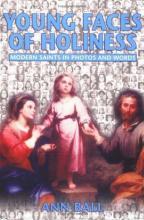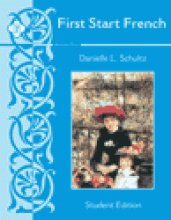No name
Young Faces of Holiness
If you want to go to sleep, don't read Young Faces of Holiness by Ann Ball. The stories are absolutely fascinating. The thirty-five stories include young people from all walks of life and countries of the world who are either Blessed, Venerable, or candidates for canonization.
In a world that feeds the imagination of children to think only of themselves, this book is a refreshing antidote to the me-ism of our modern culture. Ann Ball does a marvelous job of showing the spiritual development of these young saints. They too struggled with their faults. At the same time, they are a source of hope, because they chose to suffer or even die for Christ. We need to be reminded over and over again to strive to achieve the Divine Smile in the midst of crosses and suffering. Many of them did nothing extraordinary in terms of the world. They wanted to love God to the best of their ability. For example, although Annie Zelikova lay dying in terrible pain from tuberculosis, she was known for her constant smile. She said, "I must smile to my last breath." Another young candidate for sanctity, Gerard Raymond, wrote, "Help me, O Jesus, to love You more and more."
After reading just one or two stories, we are forced to make an examination of conscience and ask ourselves, "If they can conquer their faults, then surely I can conquer mine and strive to achieve the same attitude as these children." Although no reading level is suggested, the average 4th grader could probably read it. Since most children's comprehension level is far beyond their reading level, this book would also make an ideal read aloud to younger children. For many young children seeing pictures of these children will be an eye-opening experience. Other young people their own age tried to be holy.
Because a few of the children experienced violent deaths, you may wish to skip those stories for young children. Both Saint Maria Goretti and Blessed Antonia Mesina were brutally murdered and died defending their purity because of their love of Christ.
Note from the Webmaster: I would like to suggest that this book is ideally suited to pre-teens and teenagers (approximately 6th grade and up) who will be able to reflect on the heroism of these children under difficult circumstances (and sometimes extreme suffering) and be inspired to apply some measure of that heroism to their own lives.
Amazing Saints
Available from www.amazingsaints.com.
Belisarius
First Start French
The teacher book has very well-written supplementary notes for teaching each lesson.
There is a Level 2 set now available.
Friendly Defenders
Each packet of Friendly Defenders Catholic Flash Cards includes 50 cards covering 12 categories: Tradition, Church, Papacy, Eucharist/Mass, Salvation, Purgatory, Baptism, Mary, Saints, Confession, Statues & Holy Objects, and Holy Orders. The purpose of the cards is to assist children, ages 8 and up, and teenagers to be able to defend their faith with clear and easy explanations against the typical questions about the Catholic faith.
On the front of each card is a number and color code, category and topic, a boy or girl (with a memorable name such as Curious Connie) who offers a challenging a question or statement to Catholics. On the back of each card is another boy or girl (with a name such as Joyful Joey) giving a solid Catholic response. There is also a Bible verse and additional comments at the bottom of the card to explain the answer. Also included are Bible references with related Bible verses. For example, in the Category of "Purgatory" and the topic of "Purpose of . . .", Questioning Quincy states, "Purgatory is not necessary. You're either saved or not saved." Gracious Grace gives the reply on the back. "Purgatory is only for the saved. It's a place or state where those who died in God's friendship are made perfect so they can enter heaven of which St. John writes. . . 'Nothing unclean will enter it' (Rev. 21:27).
These cards are unique in that they are not just basic catechism questions, but questions that non-Catholics often have about the Catholic faith and these cards supply young people the tools to effectively reply to those misconceptions. Colorful and contemporary, Friendly Defenders Catholic Flash Cards offer kids a fun way to learn to defend the faith.
Old Sam, Dakota Trotter
The Joy of Science
Joy Hakim is a talented story-teller, as readers of her American history series can attest. Her presentation of the history of science, ably illustrated with colored images of scientists and their apparatus and their books will engage the student and readily acquaint him with all that he is likely to be expected to know (in the politically correct sense) about the history of science.
It is the "politically correct" aspect that warrants some caution.
Joy Hakim is not herself either a scientist or a historian, and several annoying but commonplace and politically correct assumptions about science are reinforced by her work, to wit:
- That religion and science are in conflict.
- That the history of science basically begins with the Greeks, pauses for the Dark Middle Ages, and resumes for the Reformation/ Enlightenment.
- That science involves a particular type of thought, in the long run the best kind of thought and the only one that is really dependable and serious.
- That science fiction is a source of suggestive ideas about the nature of man, and since it has a veneer of science, these suggestions will be welcomed by all men of good intelligence.
Here are some of the details of her thought about religion being in conflict with science.
The presentation of science as a constant conflict with religion begins at the beginning of the text. On p. 48, for example we learn that the religious and political leaders were "aghast" with the ideas of Anaxagoras (500 – 428 B.C.), who said that the Moon had mountains and shone by the reflected light of the sun. It is a curious fact that in writing this first volume, titled: Aristotle Leads the Way, Hakim does not note that Aristotle himself, several generations after Anaxagoras, in 350 B.C., rejected these ideas about the Moon. This is important because it shows that the academics were in disagreement among themselves, not busily making "Scientific Progress" except as inhibited by hysterical religious leaders.
The battle continues on p. 91 (in a sidebar) where Hakim laments that unfortunately we can't read the works of Democritus because they were destroyed by religious zealots. Whom does she mean? Plato wanted to burn his writings, but did not have the power to do so; worth mentioning to recognize that there were academic conflicts about his ideas. Some claim that the books were burned in 391 by Christian monks; this refers to some sort of political chaos in which the Library at Alexandria was damaged, but it has nothing to do with singling out Democritus. Caliph Omar ordered that all the books in the Alexandrian Library – excepting the works of Aristotle -- be burned to heat their baths in 642. Again, Democritus was not singled out. And by the way, now we know why Aristotle so dominates our knowledge of Greek thought. Thanks, Omar.
Finally, it is worth mentioning that the books in this library contained a mixture of sorcery and science; this was the source of the discord. I would probably burn a good number of the books myself if they were found in my family library. Of course I would want to sort them first, and 700,000 books is more than I can sort…
So much for religious zealots.
Skipping ahead, chapter 22 is entitled, "A Saint who was No Scientist" referring to St. Augustine. Actually, for his time Augustine was moderately good at science, considering that it was not his primary vocation. He specifically urged that the Christians not say things about science that pagans would certainly dismiss as stupid for this might cause them to dismiss the gospel, -- good advice today. And he made a mammoth effort to bring the understanding of Genesis 1 up to date – his date.
To her credit, Hakim mentions that some scholars dispute the idea that the dark ages were so very dark, and she urges her readers to do their research. This is a little unfair. The idea of writing a textbook is that you are laying out the essentials and the readers may do further research. She doesn't even list the people they might research in order to consider the merits of Medieval science:
- St. Isidore of Seville in the 7th century, St. Bede in the 8th century, and Rabanus Maurus in the 9th century all worked on encyclopedias, humble efforts to set forth what was known in an orderly manner. Coming out of the piracy that marked the fall of Rome, these efforts were humble but important for the resumption of culture.
- John Scotus Eriugena (12th century) set forth a layout of the heavens with Mercury, Venus, Earth, Mars and Jupiter orbiting the Sun, though not Saturn.
To be sure, Hakim's book actually has marginal notes and side bars with other resources that might be pursued, but since these are not well-integrated into the text, a student might not notice them as a resource for further research.
This book perpetuates too many falsehoods to be worthwhile.
Peter Treegate's War
Because of the impersonal nature of the battle scenes and the need for a mature understanding of the issues surrounding war, the suggested reading level is high school.









